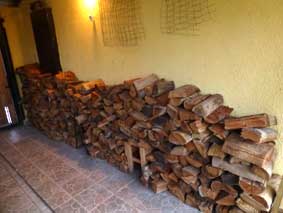
For the first time in several deliveries of firewood, it actually looks the full amount promised.

And, to my delight, almost all appeared to be under 20% water. The two observations have an important connection.
Strangely (especially for such a humid area), firewood is sold here by weight. So (keeping it simple) if all the wood were 20% water, you pay for 200 kg of water and 800 kg of combustible material. When I did some readings at woodlots a while back after a couple days of rain, some were showing 35% water. “Oh but don’t worry,” they told me, “it’s just because of the rain. It’s been dried, and it will dry out again in a few days.” Meanwhile please pay the same amount for 350 kg of water and only 650 kg of combustible material.
The logic of which either escapes, or doesn’t concern, them the least.
dry is good, but it also burns much faster as well. some humidity is not bad
Ideal, according to the installers of our airtight wood stove, is 15-20%. Whether the much more expensive wood (because you're buying water) at 30-35% would burn slower, I don't know.What I've observed in Uruguay is that people *burn* firewood rather than actually *heat* with firewood. Fireplaces I've seen are often poorly designed (no angled sides to reflect heat, too deep), whose main effect is to draw cold air inside through bedroom windows, and send it outside again as hot air up the chimney. The open metal “fireplaces” are better, because the conductive heat radiates from the outside metal surface (lost to brick mass for the most part in brick fireplaces), but still they're pumping a lot of heat up the chimney and out of the house. In those cases, the longer the fire lingers, the better, I guess.Also, isn't the risk of burning firewood that's too dry somewhat mitigated by winter weather here on the coast, where the relative humidity is seldom less than 70% or so? 😉